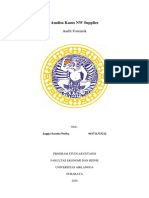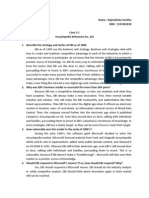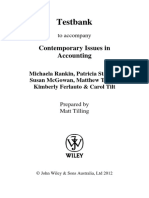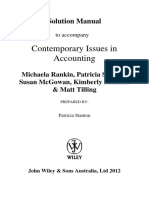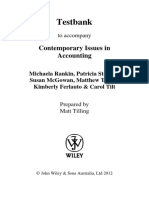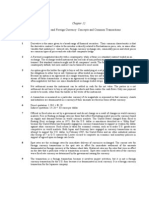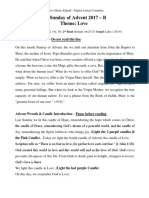Contemporary Issues in Accounting: Solution Manual
Contemporary Issues in Accounting: Solution Manual
Uploaded by
KeiLiewCopyright:
Available Formats
Contemporary Issues in Accounting: Solution Manual
Contemporary Issues in Accounting: Solution Manual
Uploaded by
KeiLiewOriginal Title
Copyright
Available Formats
Share this document
Did you find this document useful?
Is this content inappropriate?
Copyright:
Available Formats
Contemporary Issues in Accounting: Solution Manual
Contemporary Issues in Accounting: Solution Manual
Uploaded by
KeiLiewCopyright:
Available Formats
Solution Manual
to accompany
Contemporary Issues in
Accounting
Michaela Rankin, Patricia
Stanton, Susan McGowan,
Kimberly Ferlauto & Matt Tilling
PREPARED BY:
Michaela Rankin
John Wiley & Sons Australia, Ltd 2012
Chapter 11: Sustainability and Environmental Accounting
CHAPTER 11
SUSTAINABILITY AND ENVIRONENTAL
ACCOUNTING
Contemporary Issue 11.1: Perfect timing for world’s first: Carbon
Neutral Winery
1. Outline the potential costs and benefits of making moves towards carbon
neutrality. (J)
Costs would include putting a system in place to measure greenhouse gas emissions
before they can be managed and mitigated; changing practices and training of staff to
mitigate emissions; the cost of changing agricultural practices; changing transport
used; costs of certification etc.
Benefits would include an increase in sales, particularly to customers specifically
interested in the origin of their products; increasing marketing opportunities to
different retailers, such as supermarkets signing up to a food miles program; energy
savings, and therefore reduction in energy costs.
2. The ‘food miles’ movement is increasing in strength in the United Kingdom,
with some major retailers, for example Tesco, asking suppliers to label
products with their carbon footprint. Evaluate what impact this move could
have on the New Zealand wine industry. (J)
New Zealand wineries that embrace the carbon neutral concept and seek certification
are likely to increase their market share in the United Kingdom, as they are meeting
their requirements for labeling. They are likely to take market share from wineries in
other countries, which are not considering these moves. It is likely to act as a
marketing opportunity and increase the industry’s exposure to different markets and
customers.
© John Wiley and Sons Australia, Ltd 2012 11.1
Solution manual to accompany: Contemporary Issues in Accounting
Review questions
1. Explain the meaning of sustainability and outline why corporations might
consider it in their business operations.
Sustainability, or sustainable development, is concerned with development that meets
the needs of the present without compromising the ability of future generations to
meet their own needs. It refers to three main areas – economic development,
environmental development and social development.
Corporations might consider their effect on sustainability as they are in control of the
majority of the earth’s resources so any moves towards sustainability cannot occur
without the support of business. Figure 11.1 presents reasons that BHP Billiton
embraces sustainable development. These include: to reduce business risk and
enhance business opportunities; to gain an maintain their ‘licence to operate’ – which
is also referred to as a social contract; to improve operational performance and
efficiency; improved attraction and retention of its workforce; maintain security of
operations; enhanced brand recognition and reputation and to enhance their ability to
strategically plan for the longer-term.
2. Explain the difference between eco-justice and eco-efficiency, and explain how
both might relate to business activities.
Eco-justice considers the ability to meet the needs of the current inhabitants, including
strategies to alleviate poverty, access to basic water, food and shelter. It also takes a
long-term focus where it recognizes that consumption of resources today needs to
consider the effect this will have on the quality of life of future inhabitants. These
two aspects of eco-justice are referred to as intragenerational equity and
intergenerational equity respectively. Eco-efficiency, on the other hand, focuses on
how efficiently resources are used to minimize the impact on the environment.
Some businesses are larger than some governments. As such, they have a great deal of
power over resources. Given businesses control the majority of the world’s resources,
entities can put systems in place to contribute to the efficient use of these resources to
meet eco-efficiency demands. They also have control over the extent to which
resources are depleted to avoid eco-justice considerations relating to intergenerational
equity. Many businesses operate globally, so are in a position to be able to assist to
alleviate poverty, and ensure their employees in developing countries, and their
communities have access to food, clean water and shelter.
3. What reasons can an entity provide for adopting sustainable development?
There are a number of reasons that businesses can provide for adopting sustainable
development. A good discussion is provided in Figure 11.1, which presents reasons
that BHP Billiton embraces sustainable development. These include: to reduce
business risk and enhance business opportunities; to gain an maintain their ‘licence to
© John Wiley and Sons Australia, Ltd 11.2
Chapter 11: Sustainability and Environmental Accounting
operate’ – which is also referred to as a social contract; to improve operational
performance and efficiency; improved attraction and retention of its workforce;
maintain security of operations; enhanced brand recognition and reputation and to
enhance their ability to strategically plan for the longer-term.
4. Identify what information entities are likely to provide if they use triple
bottom line reporting.
Triple bottom line reporting is also referred to as environmental, social and
governance reporting and sustainability reporting. Companies are likely to provide
information about their financial performance, their environmental performance and
their social performance.
5. Explain the difference between sustainability reporting and traditional
financial reporting.
Traditional financial reporting focuses on recognising the financial effects of an
entity’s transactions. It follows generally accepted accounting principles and
accounting standards and is audited by an external auditor. The financial report is
limited to transactions that have a financial impact. Sustainability reporting however
goes beyond this. It includes reporting on the environmental activities and of the
entity as well as its social impacts. These are combined with financial information.
6. What benefits should entities expect from preparing sustainability reports?
The following benefits can be gained from preparing sustainability reports:
Embedding sound corporate governance and ethics systems throughout the
organisation
Improved management of risk through enhanced management systems and
performance monitoring
Formalising and enhancing communication with key stakeholders
Attracting and retaining competent staff
Ability to benchmark performance with other entities.
7. What is international integrated reporting and how does it differ from the
current financial reporting system we have?
Integrated reporting is designed to improve sustainability reporting and integrate it
more closely with financial and governance reporting. It is designed to bring together
financial, environmental, social and governance information in a clear, concise,
consistent and comparable format. It differs from our current financial reporting
system as it goes beyond the financial impact of activities, and a general disclosure of
© John Wiley and Sons Australia, Ltd 2012 11.3
Solution manual to accompany: Contemporary Issues in Accounting
governance to include a framework to integrate environmental and social reporting
together in an integrated way.
8. What is the Global Reporting Initiative, and what is its purpose?
The Global Reporting Initiative was launched in 1997 as an initiative to develop a
globally accepted reporting framework to enhance the quality of sustainability
reporting. It provides a framework of principles and performance indicators that
organisations can use to measure and report their social and environmental
performance. Its purpose is to enhance the transparency, comparability and clarity of
sustainability reports.
9. Identify four corporate stakeholders and explain how they affect a business’s
operations.
Table 11.3 provides examples of a range of stakeholders. These can include:
Shareholders – provide funds to the entity. Their support is essential for continued
success of the entity, as their support affects share price and corporate value.
Customers – major users of the entity’s products and services. A continued and
growing supply of customers is essential to the continued success of the entity.
Fund investors – like shareholders, they buy shares in the company and support
companies for which they see opportunities for growth in value.
Community groups – may supply labour to the entity, but need to support the entity’s
operations if the entity and community are to exist harmoniously.
Media – can impact the views of other stakeholders by voicing concerns and making
other groups aware of the businesses operations and activities
Government and regulators – monitor mandatory reporting, impose taxes and charges
and uphold legislation that the entity needs to follow.
10. For the four corporate stakeholders you have identified above, document
how an organisation might engage with them about sustainability issues.
Entities can engage with these stakeholders in the following ways:
Shareholders – direct emails, provide information in annual reports and stand-alone
sustainability reports, website.
Customers – directly through email and other written communication. The media and
the corporate website would also be useful.
Fund investors – direct communication through email, phone, meetings with fund
managers, and through providing sustainability information in written form, for
example the sustainability report.
© John Wiley and Sons Australia, Ltd 11.4
Chapter 11: Sustainability and Environmental Accounting
Community groups – can use the media, company website, attending community
meetings, and through local government
Media – media releases, direct communication through email, phone and by providing
copies of sustainability reports.
Government and regulators – direct reporting to show are compliant with regulations,
email and phone.
11. Identify how ethical investment can affect corporate decision making
regarding sustainable business operations.
Ethical investment and the growth in ethical funds pose an increasing influence on
entities’ corporate sustainability performance and reporting. Increasing demands for
social and environmental performance information means that companies are seeking
to satisfy their needs to attract funds and support. Being listed on a sustainability
index such as one of the Dow Jones Sustainability Indexes means companies can also
attract investment and support from fund managers and small investors who are
driven in their investment choice by ethical, social and/or environmental
considerations.
12. Explain what an environmental management system is and how it can be
used to improve environmental performance.
An environmental management system (EMS)is a system that organisations
implement to measure, record and manage their environmental performance. It is
useful to assist in improving environmental performance because it allows entities to
measure and record their performance, set benchmarks or key performance indicators,
and put in place mechanisms to meet these benchmarks. It is often said you can’t
control what you can’t measure. An EMS allows an entity to measure its
environmental outputs in order to look towards controlling and reducing them, thus
improving performance.
13. Explain how emissions trading schemes are likely to affect financial
reporting.
An emissions trading schemes is a system designed to control emissions by allowing
participants to trade excess emissions permits. This is likely to affect financial
reporting because it will require companies to measure and report emissions permits it
holds, through grants from government and those it purchases. There are also likely to
be financial implications from the trade of permits. While there are currently no
financial reporting guidelines around the operation of an emissions trading scheme it
is likely that emissions permits are likely to be reported as either financial instruments
or intangible assets, and both are used in jurisdictions which currently have an
emissions trading scheme in place.
© John Wiley and Sons Australia, Ltd 2012 11.5
Solution manual to accompany: Contemporary Issues in Accounting
Application questions
11.1 There are currently no formal accounting standards for the reporting of
social and environmental activities. Evaluate what issues this has for
preparation of financial reports. (J, K)
Given there are currently no formal accounting standards for the reporting of social
and environmental activities this means that these activities are not going to be
included in the transactions reflected in the financial statements. For example, an
entity’s impact on the environment, in terms of pollution is not costed and included as
an expense. While entities are required to account for the present value of future
cleanup costs of contaminated sites, they do not have to account for the ongoing
impact of this contamination on the environment. Similarly, entities are not currently
required to account for any social cost which does not have a direct financial impact..
While some disclosures are required concerning employee benefits,
11.2 In this chapter a range of stakeholders have been identified that managers
should consider when determining their sustainability performance and
reporting. Determine how managers should engage with each one of these
stakeholders and document what sustainability issues they would be likely
to discuss during this engagement process. (J, K)
Shareholders – direct emails, provide information in annual reports and stand-alone
sustainability reports, website. The entity would be likely to discuss their sustainable
business activities and how these will add to firm value. This might also include how
it is addressing legislation on carbon emissions.
Customers – directly through email and other written communication. The media and
the corporate website would also be useful. Customers may be interested in the source
of products, with some actively seeking green or fair trade products. Consequently
entities will communicate the environmental credentials of products including the
extent to which they are sourced from sustainable sources.
Fund investors – direct communication through email, phone, meetings with fund
managers and through providing sustainability information in written form, for
example the sustainability report. Some investors search out socially responsible
companies to invest in. Entities will report their social and environmental activities to
attract ethical fund investors. Managers will also discuss how the entity is addressing
issues such as carbon emissions disclosure and reduction requirements.
Community groups – can use the media, company website, attending community
meetings, and through local government. Entities will discuss facilities and services
provided to local community groups, and issues such as job creation, health, and
emissions information relating to the local environment.
Media – media releases, direct communication through email, phone and by providing
copies of sustainability reports. Given the media acts as a voice that sets the agenda
relating to many issues an entity will wish to advise any positive social and
environmental activities.
© John Wiley and Sons Australia, Ltd 11.6
Chapter 11: Sustainability and Environmental Accounting
Government and regulators – direct reporting to show are compliant with regulations,
email and phone. The entity will discuss the potential impacts of legislative changes
relating to social and/or environmental activities.
11.3 Obtain the 2011 Sustainability Report for Toyota Ltd. Prepare a report
that addresses the following issues:(J, K, CT)
The 2011 Sustainability Report for Toyota Ltd is presented for the first time online.
(a) Document Toyota’s vision and mission statement, and articulate how these
might relate to sustainability, if at all.
Our vision
Most respected and admired company.
Our mission
We deliver outstanding automotive products and services to our customers, and enrich
our community, partners and environment.
Our four core values
Customer first
Respect for people
International focus
Continuous improvement and innovation.
While the vision does not specifically relate to sustainability, the mission and core
values do. In Toyota Ltd’s mission they discuss enriching the community and
environment. This will lead to organizational strategies to address these sustainability
issues. In addition one of the company’s four core values is respect for people,
implying a social focus beyond a profit motive.
The company also has a separate environment vision and action plan.
(b) Outline Toyota’s stakeholders and explain how they have engaged each of
these stakeholder groups.
In its sustainability report under ‘Stakeholder Engagement’ the following table
highlights stakeholders groups the company engages with and how:
Stakeholder Key Issues Response and Engagement in 2010/11
Group
Employees Employee Working at Toyota, communication broadcasts
satisfaction and job and employment programs
security
Career and Learning and development programs via Toyota
professional Institute Australia. Read about our Employees
development
Customers Customer service Customer satisfaction surveys
Product quality Interaction via dealerships
© John Wiley and Sons Australia, Ltd 2012 11.7
Solution manual to accompany: Contemporary Issues in Accounting
Customer Experience Program
Business Effects of Great East Dealer support during natural disasters
partners - Japan Earthquake and
dealers natural disasters in
Australia
Environmental Dealer Environmental Risk Audit Program and
impacts Toyota Environmental Dealership Program
Ongoing Dealer training
development
Business Effects of Great East Annual Supplier conference
partners - Japan Earthquake and
suppliers natural disasters in
Australia
Self-reliance Supplier Development Programs
Community Contribution to local Local and national community partnerships
community
Community sponsorships
Government Ongoing viability of Regular interaction on key issues such as
Australian production of next generation engine at Altona
automotive market plant
Written submissions including NPI, EEO and
NGERS
Toyota Motor Efficient operations Regular liaison on operating issues including
Corporation product quality, sales and marketing
The company also discusses a Community Liaison Committee under its
Altona Environmental Improvement Plan and a Stakeholder Engagement
Survey.
(c) Outline governance mechanisms in place on the Board of Directors to
address sustainability.
Under the ‘Governance’ section of the report the company reports that the board has
an Environment Committee and a Health and Safety Committee. Both of these would
address sustainability issues.
(d) Articulate how Toyota Ltd links sustainability to its risk management
systems.
Toyota Ltd does not disclose information in its 2011 report on how it links
sustainability to its risk management system. A perusal of the 2010 report, however,
discussed the Enterprise Risk Management process that is used to develop a risk
profile for each business unit, which is then used for planning yearly objectives. The
organization was in the process of integrating the risk management process into other
business planning and management systems at that time.
© John Wiley and Sons Australia, Ltd 11.8
Chapter 11: Sustainability and Environmental Accounting
(e) Outline any guidance Toyota Ltd used in implementing environmental and
social performance and reporting systems.
The company has gained ISO14001 certification for its environmental management
system so has used the guidance of the quality system in its implementation. The
company also uses the Global Reporting Index (GRI) to develop and present its
sustainability report. It has been assessed by the GRI as meeting level A.
11.4 You are the accountant of a company that is considering expanding its
operations to a country in the developing world. You are to prepare a
report to the CEO outlining what issues the company should consider from
a sustainability perspective when making this decision. (J, CT)
There are a range of issues the CEO needs to consider from a sustainability
perspective. These include but are not limited to:
Environmental impacts of the activities
Access to resources using sustainable transport methods
Depletion of resources to the detriment of the local community
Providing appropriate wages and facilities for employees. It is likely that the
company will need to provide additional support in the form of shelter, food
and water to employees and their families
Government regulations
© John Wiley and Sons Australia, Ltd 2012 11.9
Solution manual to accompany: Contemporary Issues in Accounting
Case Study Questions
Case study 11.1: Turning the heat on
1. Outline how climate change is likely to affect Sewell’s business operations in
developing countries. (J, K)
Climate change affects developing countries arguably more than in developed
countries for a number of reasons. Poor infrastructure is one major factor, as is a lack
of resources. A lack of government regulation over business and infrastructure
development means emissions are not measured or controlled. Developing countries
seeking investment from foreign organisations are likely to not pay attention to the
systems put in place to minimize emissions.
2. Evaluate the social issues likely to impact on a business operating in a
developing country. (J, K)
Limited education is likely to affect the skills of potential employees. Employees are
also likely in many cases to be malnourished and lack transportation to get to work.
This is also likely to lead to higher levels of illness amongst employees than would be
the case in developed countries. Businesses are likely to have to consider supporting
staff and their families through the provision of basic needs such as food, water and
shelter. They are also likely to need to build infrastructure to support the local
community as well as the business.
3. Evaluate what role accountants can play in addressing climate change in a
business environment. (J, K)
To manage climate change and carbon emissions entities need to be able to measure
their outputs. Accountants work with the major information systems of the
organization and so are in a position to contribute to the development of an
information system that can measure and record emissions as a first step to managing
and reducing them. They can also attempt to measure the cost to the business of
incurring these emissions, particularly when an emissions trading scheme is used.
Case study 11.2: Dutch group seeks to tie executive bonuses to social
responsibility
1. The company that employs you is a manufacturing firm. It is considering
following the lead of DSM and developing some performance indicators to tie
executive bonuses to environmental performance. Outline what some of these
might be. (J, K)
A company wishing to tie executive bonuses to environmental performance could
consider the following indicators, amongst others:
Energy usage and savings
Greenhouse gas emissions
Reduction in waste
Product development that minimizes environmental impacts
© John Wiley and Sons Australia, Ltd 11.10
Chapter 11: Sustainability and Environmental Accounting
2. Document measures of performance relating to social issues, such as employee
and consumer relations that should also be considered. Explain your answer.
(J,K)
Measures of performance relating to social issues could consider:
Employee injury rates
Employee satisfaction
Investments in community activities
Stakeholder management indicators
Consumer complaints
Case study 11.3: Super funds set to track down carbon footprints
1. Identify why you would expect the finance sector, and investment funds in
particular, to have an interest in climate change. (J, K)
Climate change and greenhouse gas emissions are becoming an increasing area of risk
and associated costs for corporations. How companies manage these risks is important
to the finance sector, and investment funds in particular as investors are likely to wear
the cost of significant changes an entity needs to make to reduce its carbon emissions
in the future. This will lead to ongoing reduction in income and firm value.
2. Outline potential sources of information that superannuation funds could use
to gather data about a company’s sustainability operations. (J, K)
Superannuation fund managers could contact the company directly in the first
instance. They can rely on publicly available information such as the annual report,
sustainability report or the corporate website. They could also seek access to
government data from the National Pollutant Inventory. Superannuation fund
investor could also become signatories to the Carbon Disclosure Project and access
information about carbon emissions about the top 200 Australian and top 50 New
Zealand companies, together with firms from a large number of other countries. They
could also seek information about how a company compares to those listed on an
index such as the Dow Jones Sustainability Indexes.
3. Outline methods superannuation funds could use to encourage companies to
take a more active role in managing climate change. (J, K)
Superannuation funds could take a number of different approaches. This can include
lobbying the company to seek a change in their performance, or join the CDP and
seek change through this group. They could raise the issue of climate change at
general meetings. They could also choose to boycott investment in companies that do
not put in place mechanisms to manage climate change.
© John Wiley and Sons Australia, Ltd 2012 11.11
You might also like
- CSWIP 3.1 Question and AnswerDocument31 pagesCSWIP 3.1 Question and AnswerDevendran Marappan92% (59)
- Solution Manual For Cornerstones of Managerial Accounting 6th Edition by Mowen PDFDocument6 pagesSolution Manual For Cornerstones of Managerial Accounting 6th Edition by Mowen PDFRonyka TarrielaNo ratings yet
- AFC Coaches Log BookDocument10 pagesAFC Coaches Log BookRais Fakhri Bin Azha100% (3)
- Desktop Solution IncDocument6 pagesDesktop Solution IncAmira Nur Afiqah Agus Salim0% (1)
- Tugas Audit Forensik Week 14Document11 pagesTugas Audit Forensik Week 14juppa Saroha Purba100% (2)
- Accounting Theory Chapter 4Document18 pagesAccounting Theory Chapter 4gabiNo ratings yet
- Ch08 TB RankinDocument7 pagesCh08 TB RankinAnton VitaliNo ratings yet
- Solution Manual Contemporary Issues in Accounting 1st Edition by Michaela Rankin slw1027 PDF FreeDocument46 pagesSolution Manual Contemporary Issues in Accounting 1st Edition by Michaela Rankin slw1027 PDF Free--bolabola100% (1)
- Tugas MCS Case2-1 SD 3 NajmalindaZenithaDocument4 pagesTugas MCS Case2-1 SD 3 NajmalindaZenithaNajmalinda ZenithaNo ratings yet
- Auditing (Arens) 14e Chapter 3 PowerPoint SlidesDocument38 pagesAuditing (Arens) 14e Chapter 3 PowerPoint SlidesMohsin AliNo ratings yet
- Ch05 TB RankinDocument8 pagesCh05 TB RankinAnton VitaliNo ratings yet
- Ch09 TB RankinDocument6 pagesCh09 TB RankinAnton Vitali100% (1)
- Contemporary Issues in Accounting: Solution ManualDocument20 pagesContemporary Issues in Accounting: Solution ManualKeiLiew0% (1)
- Ch11 TB RankinDocument6 pagesCh11 TB RankinAnton Vitali50% (2)
- ch04 SM RankinDocument23 pagesch04 SM RankinSTU DOC100% (2)
- Ch04 TB RankinDocument8 pagesCh04 TB RankinAnton VitaliNo ratings yet
- Ch06 TB RankinDocument7 pagesCh06 TB RankinAnton VitaliNo ratings yet
- Contemporary Issues in Accounting: Solution ManualDocument10 pagesContemporary Issues in Accounting: Solution ManualKeiLiewNo ratings yet
- Ch14 TB RankinDocument7 pagesCh14 TB RankinAnton VitaliNo ratings yet
- Solution Manual Advanced Financial Accounting 8th Edition Baker Chap012 PDFDocument79 pagesSolution Manual Advanced Financial Accounting 8th Edition Baker Chap012 PDFYopie ChandraNo ratings yet
- Managerial Accounting - 2Document2 pagesManagerial Accounting - 2Layla AfidatiNo ratings yet
- ch12 Beams12ge SMDocument13 pagesch12 Beams12ge SMElga AstriNo ratings yet
- Ch02 TB RankinDocument8 pagesCh02 TB RankinAnton VitaliNo ratings yet
- Ch10 TB RankinDocument6 pagesCh10 TB RankinAnton Vitali100% (1)
- Foreword: Financial Auditing 1 - 9 Edition - 1Document37 pagesForeword: Financial Auditing 1 - 9 Edition - 1meyyNo ratings yet
- Chapter 11 - Solution ManualDocument28 pagesChapter 11 - Solution ManualjuanNo ratings yet
- Theories in Accounting: ©2018 John Wiley & Sons Australia LTDDocument57 pagesTheories in Accounting: ©2018 John Wiley & Sons Australia LTDdickzcaNo ratings yet
- Materi Meet 10 Evaluating, Recording MethodsDocument12 pagesMateri Meet 10 Evaluating, Recording MethodsSiti Nuranisa AziarNo ratings yet
- Case 1-1 Sources of GAAPDocument6 pagesCase 1-1 Sources of GAAPBella TjendriawanNo ratings yet
- Nontax Costs of Tax Planning - 6Document30 pagesNontax Costs of Tax Planning - 6Tanvir HossainNo ratings yet
- Self Study Solutions Chapter 13Document11 pagesSelf Study Solutions Chapter 13ggjjyy0% (1)
- Tugas Week 10Document6 pagesTugas Week 10Carissa WindyNo ratings yet
- Ch07 TB RankinDocument8 pagesCh07 TB RankinAnton VitaliNo ratings yet
- Chapter 1 Introduction To International AccountingDocument24 pagesChapter 1 Introduction To International AccountingGendis Freyona100% (1)
- Soal GSLC-6 Advanced AccountingDocument2 pagesSoal GSLC-6 Advanced AccountingEunice ShevlinNo ratings yet
- Subramanyam 10Document53 pagesSubramanyam 10Jogja AntiqNo ratings yet
- ch18, IFRS 15Document107 pagesch18, IFRS 15Bayan KttbNo ratings yet
- Consolidation or Business CombinationsDocument17 pagesConsolidation or Business CombinationsTimothy Kawuma100% (1)
- CHPT 12 Derivatives and Foreign Currency: Concepts and Common TransactionsDocument9 pagesCHPT 12 Derivatives and Foreign Currency: Concepts and Common TransactionsKamran ShafiNo ratings yet
- ch01 SM RankinDocument14 pagesch01 SM Rankinhasan jabrNo ratings yet
- Assessing and Responding To Fraud Risks: Concept Checks P. 281Document30 pagesAssessing and Responding To Fraud Risks: Concept Checks P. 281Eileen HUANGNo ratings yet
- Intercompany Inventory and Land Profits: Solutions Manual, Chapter 6Document40 pagesIntercompany Inventory and Land Profits: Solutions Manual, Chapter 6HelloWorldNowNo ratings yet
- Advance Accounting Chapter 10Document53 pagesAdvance Accounting Chapter 10febrythiodorNo ratings yet
- 7.1. Answer The Following Questions About The Audit of Springer's Lumber &Document3 pages7.1. Answer The Following Questions About The Audit of Springer's Lumber &Nguyễn HồngNo ratings yet
- FSA 8e Ch05 SMDocument39 pagesFSA 8e Ch05 SMnufusNo ratings yet
- Financial Statement Analysis: K R Subramanyam John J WildDocument40 pagesFinancial Statement Analysis: K R Subramanyam John J WildManusha ErandiNo ratings yet
- Contemporary Issues in Accounting: Solution ManualDocument17 pagesContemporary Issues in Accounting: Solution ManualDamien SmithNo ratings yet
- ACCT-UB 3 - Financial Statement Analysis Module 2 HomeworkDocument2 pagesACCT-UB 3 - Financial Statement Analysis Module 2 HomeworkpratheekNo ratings yet
- Advanced Accounting CH 3Document35 pagesAdvanced Accounting CH 3Jan Spanton67% (6)
- AM5AMalam - Kelompok 8 - Case Study 2 SPMDocument5 pagesAM5AMalam - Kelompok 8 - Case Study 2 SPMDita EnsNo ratings yet
- Research Methodology and Theories On The Uses of Accounting InformationDocument19 pagesResearch Methodology and Theories On The Uses of Accounting Informationhamarshi201083% (6)
- Accounting For Business Combinations: Learning ObjectivesDocument41 pagesAccounting For Business Combinations: Learning Objectivesmohammad.mamdooh94720% (1)
- CR Par Value PC $ 1,000 $ 40: 25 SharesDocument4 pagesCR Par Value PC $ 1,000 $ 40: 25 SharesBought By UsNo ratings yet
- Chapter 8 - Solution ManualDocument17 pagesChapter 8 - Solution ManualjuanNo ratings yet
- Ch11 - SM - Rankin - 2e Sustainability and Environmental AccountingDocument13 pagesCh11 - SM - Rankin - 2e Sustainability and Environmental AccountingU2003053 STUDENTNo ratings yet
- CFR Unit 4Document6 pagesCFR Unit 4avinashsugumar53No ratings yet
- Sustainable Business Practices: Balancing Profit and Environmental ResponsibilityFrom EverandSustainable Business Practices: Balancing Profit and Environmental ResponsibilityNo ratings yet
- 1109 Integrated Reporting ViewDocument12 pages1109 Integrated Reporting ViewbarbieNo ratings yet
- Unit 10Document13 pagesUnit 10ammar mughalNo ratings yet
- Corporate Environmental ReportingDocument9 pagesCorporate Environmental ReportingPankaj80% (5)
- Social Accounting and Its ObjectivesDocument6 pagesSocial Accounting and Its ObjectivesIndu GuptaNo ratings yet
- Guide Questions on Sustainability ReportingDocument4 pagesGuide Questions on Sustainability ReportingKhemgee EspedosaNo ratings yet
- Script 1 ISP Plug & PlayDocument14 pagesScript 1 ISP Plug & PlaySusanto A SahriNo ratings yet
- Planning in ManagementDocument22 pagesPlanning in ManagementAnna TongcoNo ratings yet
- 4th Sunday of AdventDocument4 pages4th Sunday of AdventAjay SimonNo ratings yet
- 0460 s11 QP 11Document28 pages0460 s11 QP 11lucasNo ratings yet
- Loadcell Transmitter PF-LBPDocument2 pagesLoadcell Transmitter PF-LBPhari mulyonoNo ratings yet
- Read Carefully and Choose The Right Answer Between ADocument7 pagesRead Carefully and Choose The Right Answer Between AsulasihNo ratings yet
- Beekeeping: Enterprise BudgetDocument3 pagesBeekeeping: Enterprise Budgetjiubjub0% (1)
- Cels191 Things To RememberDocument9 pagesCels191 Things To RememberMimi BoisterNo ratings yet
- 1. Chuyen de - HS - Tu de gay nham lan-Document4 pages1. Chuyen de - HS - Tu de gay nham lan-Phương PhạmNo ratings yet
- Food ReviewDocument4 pagesFood ReviewRonaldo AstilleroNo ratings yet
- MaanthiDocument5 pagesMaanthia1n2u3s4h5a6100% (1)
- Sign Language Is Birth Right of Deaf Community-1Document13 pagesSign Language Is Birth Right of Deaf Community-1Hk SpotNo ratings yet
- Read The Text and Answer The Questions English Academic Writing: The "A" PaperDocument2 pagesRead The Text and Answer The Questions English Academic Writing: The "A" PaperКсенияNo ratings yet
- Educ 7 Chapter 1Document14 pagesEduc 7 Chapter 1Efren TurajaNo ratings yet
- Juicer ManualDocument14 pagesJuicer ManualCarlos JagodaNo ratings yet
- TFT LCD DC-DC Converter With Integrated Charge Pumps, OP-AMP and HV-SwitchDocument20 pagesTFT LCD DC-DC Converter With Integrated Charge Pumps, OP-AMP and HV-SwitchАлександрNo ratings yet
- Placement of Wind Turbines Using Genetic Algorithms: S.A. Grady, M.Y. Hussaini, M.M. AbdullahDocument12 pagesPlacement of Wind Turbines Using Genetic Algorithms: S.A. Grady, M.Y. Hussaini, M.M. AbdullahjeanNo ratings yet
- In The Context of 6G TechnologyDocument3 pagesIn The Context of 6G Technologysampathkumarbandi286No ratings yet
- Steam NozzlesDocument50 pagesSteam NozzlesPRAVEEN100% (1)
- Mid Term Exam - FE 63 240226Document3 pagesMid Term Exam - FE 63 240226Mai AnhNo ratings yet
- China Interview - EnglishDocument8 pagesChina Interview - EnglishNelia BuruianaNo ratings yet
- Naphtha Hydrotreating UnitDocument1 pageNaphtha Hydrotreating UnitKmt_Ae100% (1)
- The Doors - Touch MeDocument23 pagesThe Doors - Touch MeDiego David Novoa GuillenNo ratings yet
- Duality Theory For Clifford Tensor PowersDocument47 pagesDuality Theory For Clifford Tensor PowersSergioGimenoNo ratings yet
- Workbook 1° Cuatrimestre BachDocument24 pagesWorkbook 1° Cuatrimestre Bachfatima araizaNo ratings yet
- Minor Design FLOOR PLANS 2Document1 pageMinor Design FLOOR PLANS 2siddarth reddyNo ratings yet
- 5 Powerful Lessons in The Life of Cain and Abel 1Document5 pages5 Powerful Lessons in The Life of Cain and Abel 1Mercy Balagosa Palmares100% (1)
- Pfaff 259 Sewing Machine Instruction ManualDocument54 pagesPfaff 259 Sewing Machine Instruction ManualiliiexpugnansNo ratings yet




